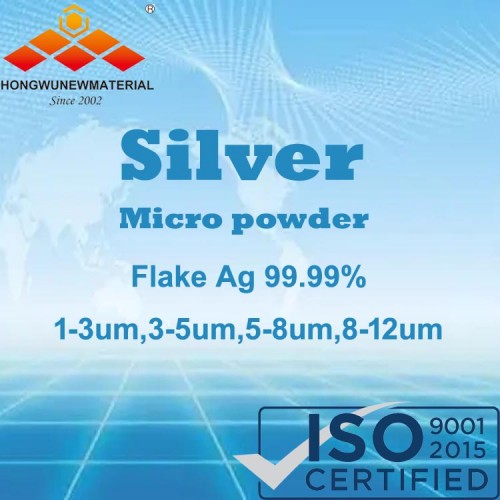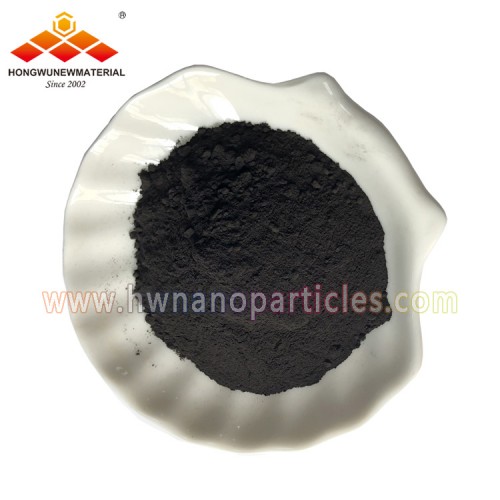
Super fine conductive Ag silver powders Flake 99.99%
| Stock# | Size | Bulk Density (g/ml) | Tap Density (g/ml) | SSA(BET) m2/g | Purity % | Morpholgoy |
| HW-FB11501 | 1-3um | 0.6-1.2 | 2.0-3.0 | 1.5-2.5 | 99.99 | Flake |
| HW-FB11502 | 1-3um | 1.5-2.5 | 3.5-4.2 | 2.5 | 99.99 | Flake |
| HW-FB11601 | 3-5um | 0.6-1.2 | 2.0-3.0 | 1.5-2.5 | 99.99 | Flake |
| HW-FB11602 | 3-5um | 1.5-2.5 | 3.5-4.2 | 2.5 | 99.99 | Flake |
| HW-FB11701 | 5-8um | 0.6-1.2 | 2.0-3.0 | 1.5-2.5 | 99.99 | Flake |
| HW-FB11702 | 5-8um | 1.5-2.5 | 3.5-4.2 | 2.5 | 99.99 | Flake |
| HW-FB11703 | 8-12um | 1.8-2.0 | 3.5-4.2 | 0.6-1.0 | 99.99 | Flake |
| Note:Other specifications can be customized according to requirements, please tell us the detailed parameters you want. | ||||||
Flake silver powders are mainly used as conductive coating, for example High-grade coating for filters,Silver coating for ceramic capacitors,Low temperature sintered conductive paste, dielectric arc.
Also be as conductive paste, for example:Electromagnetic shielding coatings, conductive coatings, conductive inks, conductive rubber, conductive plastic, conductive ceramics, etc.
1. High-end silver paste (glue) :
Paste (glue) for internal and external electrodes of chip components;
Paste (glue) for thick film integrated circuit;
Paste (glue) for solar cell electrode;
Conductive silver paste for LED chip.
2. Conductive Coating
Filter with high-grade coating;
Porcelain tube capacitor with silver coating
Low temperature sintering conductive paste;
Dielectric paste
Silver nanoparticles have the ability to support surface plasmons, which results in unique optical properties. At certain wavelengths, surface plasmons become resonant and then absorb or scatter incident light so strongly that individual nanoparticles can be seen using a dark field microscope. These scattering and absorption rates can be tuned by altering the shape and size of the nanoparticles. As a result, silver nanoparticles are useful for biomedical sensors and detectors and advanced analysis techniques such as surface-enhanced fluorescence spectroscopy and surface-enhanced Raman spectroscopy (SERS). What’s more, the high rates of scattering and absorption seen with silver nanoparticles makes them particularly useful for solar applications. The nanoparticles act like highly efficient optical antennas; when Ag nanoparticles are incorporated into collectors, it results in very high efficiencies.
Silver nanoparticles have excellent catalytic activity and can be used as catalysts for many reactions. Ag/ZnO composite nanoparticles were prepared by photoreduction deposition of precious metals. The photocatalytic oxidation of gas phase n-heptane was used as a model reaction to study the effects of the photocatalytic activity of samples and the amount of noble metal deposition on the catalytic activity. The results show that deposition of Ag in ZnO nanoparticles can greatly improve the photocatalyst activity.
The reduction of p - nitrobenzoic acid with silver nanoparticles as catalyst. The results show that the reduction degree of p-nitrobenzoic acid with nano-silver as catalyst is much greater than that without nano-silver. And, with the increase of the amount of nano-silver, the faster the reaction, the more complete the reaction. Ethylene oxidation catalyst, supported silver catalyst for fuel cell.











